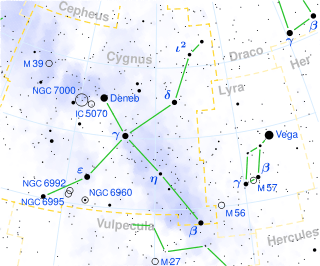RW Cygni
 Location of RW Cyg | |
| Observation data Epoch J2000 Equinox J2000 | |
|---|---|
| Constellation | Cygnus |
| Right ascension | 20h 28m 50.59s |
| Declination | 39° 58′ 54.4″ |
| Apparent magnitude (V) | 8.81 (8.05 - 9.70[1]) |
| Characteristics | |
| Spectral type | M2-4Ia-Iab[1] |
| Variable type | SRc[1] |
| Astrometry | |
| Distance | ~3,600[2] ly |
| Absolute magnitude (MV) | -6.41 |
| Details | |
| Mass | ~20 M☉ |
| Radius | 680[3] (- 980[4]) R☉ |
| Luminosity (bolometric) | 145,000[5] L☉ |
| Temperature | 3,920[3] K |
| Database references | |
| SIMBAD | data |
RW Cygni (RW Cyg / HIP 101023 / BD + 39 4208) is a variable star in the constellation Cygnus. Its average apparent magnitude is +8.81, and the star is about 75 arcseconds west of Bright Sadr (γ Cygni).
Distance
A member of the Stellar Association OB9, the satellite Hipparcos (1.28 milliarcseconds) places RW Cygni about 2,550 light years from the solar system.[6] Another study, however, raises this figure to 3,600 light-years.[7]
Characteristics
RW Cygni is a red supergiant of spectral type M2-4Ia-Iab with an effective temperature of 3,920 K. It is a large supergiant, with a radius between 680 - 980 solar radii. Using the more conservative figure, so if it is placed in the center of Solar System, it would be extend past the orbit of Mars. However, it is surpassed in size by other stars like KY Cygni, NML Cygni or BC Cygni, the latter also in the constellation Cygnus. With a mass of about 20 solar masses, it is estimated that their stellar mass loss in powder form is 3.2 × 10-9 solar masses per year.[8]
Billed as a semiregular variable star SRC, RW Cygni brightness varies from magnitude +8.0 and +9.5 with a period of approximately 580 ± 80 days.[9]
See also
References
- 1 2 3 Samus, N. N.; Durlevich, O. V.; et al. (2009). "VizieR Online Data Catalog: General Catalogue of Variable Stars (Samus+ 2007-2013)". VizieR On-line Data Catalog: B/gcvs. Originally published in: 2009yCat....102025S. 1. Bibcode:2009yCat....102025S.
- ↑ Famaey, B.; Jorissen, A.; Luri, X.; Mayor, M.; Udry, S.; Dejonghe, H.; Turon, C. (2005). "Local kinematics of K and M giants from CORAVEL/Hipparcos/Tycho-2 data. Revisiting the concept of superclusters". Astronomy and Astrophysics. 405: 165. Bibcode:2005A&A...430..165F. doi:10.1051/0004-6361:20041272.
- 1 2 Josselin, E.; Plez, B. (2007). "Atmospheric dynamics and the mass loss process in red supergiant stars". Astronomy and Astrophysics. 469 (2): 671. Bibcode:2007A&A...469..671J. doi:10.1051/0004-6361:20066353.
- ↑ Levesque, Emily M.; Massey, Philip; Olsen, K. A. G.; Plez, Bertrand; Josselin, Eric; Maeder, Andre; Meynet, Georges (2005). "The Effective Temperature Scale of Galactic Red Supergiants: Cool, but Not As Cool As We Thought". The Astrophysical Journal. 628 (2): 973. Bibcode:2005ApJ...628..973L. doi:10.1086/430901.
- ↑ Mauron, N.; Josselin, E. (2011). "The mass-loss rates of red supergiants and the de Jager prescription". Astronomy and Astrophysics. 526: A156. Bibcode:2011A&A...526A.156M. doi:10.1051/0004-6361/201013993.
- ↑ The Solar System is the group of planets that surround one large star.
- ↑ Light-years are a length measurement. 1 light year is about 9.5 trillion kilometers or 9.461e+12 km.
- ↑ A year is a form of time measurement. One year is 365 days. (except on leap-years.)
- ↑ Kiss, L. L.; Szabó, Gy. M.; Bedding, T. R. (2006). "Variability in red supergiant stars: Pulsations, long secondary periods and convection noise". Monthly Notices of the Royal Astronomical Society. 372 (4): 1721. Bibcode:2006MNRAS.372.1721K. doi:10.1111/j.1365-2966.2006.10973.x.